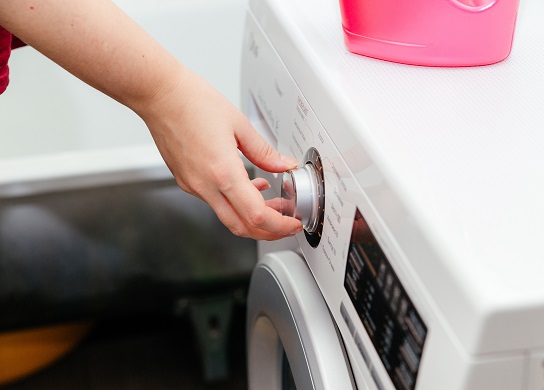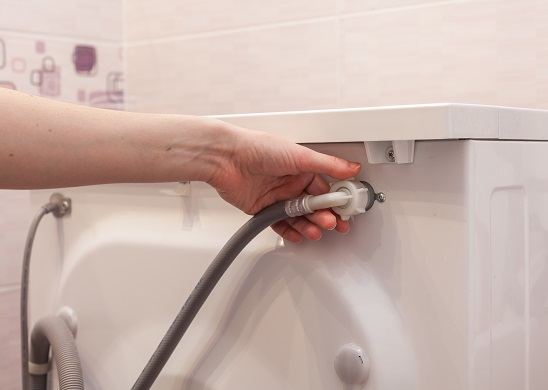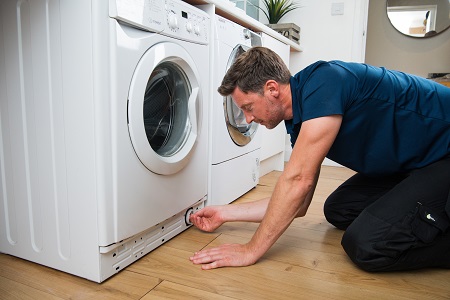Lots of water in the drum and a pile of drenched laundry suggests your washing machine won't drain. While this isn’t ideal, there's a silver lining – something as simple as a blocked filter or drain hose might explain your soggy socks. And these problems are normally easy to fix – dive in with our step-by-step instructions. We also have a guide to help if your machine won’t spin.
How to drain your washing machine

It’ll be easier to find problems with your machine after you drain the excess water away. To do this:
- Stop the machine’s program mid-cycle
- Switch it off at the wall, then unplug it
- Place a towel on the floor and lay a shallow tray on top to catch the water
- Remove the filter cover* and pull the cap off the hose
- Let the water drain into the tray**
*This is usually found in the bottom right corner on the front of the machine.
**You might need to empty the tray and replace it a few times until all the water has gone.
How to find what’s causing the problem
Now you’ve got rid of the water, you can cast your eye over the different parts of your machine.
1. Check the pump filter

To inspect and clean the washing machine pump filter:
- Unscrew the filter cap in an anti-clockwise direction
- Allow any remaining water to drain into the tray and remove any loose objects like coins or keys
- Clean the filter under warm water
- Spin the impeller (a plastic propeller at the back of the filter) with your fingers to clear away any debris
- Reinsert the filter and close the cover
Once you’re all done, turn the power back on and see if the machine will drain again.
2. Check the drain hose for blockages or kinks

If the filter looks ok, the drain hose at the back of your machine might be kinked or blocked.
First, make sure you have these items to hand:
- Pliers
- A towel
- A bucket or container
- A torch
- Drain cleaner
Then follow these steps:
1. Switch off the machine and take out the mains plug
2. Turn off your home’s water supply at the stopcock
3. Loosen the metal drain hose clamp with pliers
4. Slide the clamp up the hose so it’s out of the way
5. Place a towel underneath in case there’s escaping water
5. Use the pliers to loosen the hose until it comes away from your machine
6. Carefully pour any water out of the hose into your bucket
7. Run water through it to flush out any clogs*
8. Check there are no kinks, bends or twists in the hose
9. Reconnect it and turn your water supply back on
*Use a torch if it’s hard to see and drain cleaner to dissolve any stubborn clogs.
3. Make sure the drain hose is in the right position
Another washing machine fault that can cause drainage issues is an incorrectly installed drain hose. It needs to be connected to the waste pipe at the right height to stop water from flowing back into the machine. Read your appliance’s user manual for instructions on how high to position the hose. If it’s too short, you’ll need to buy an extension pipe from a DIY store.
What to do if this doesn’t fix the problem
If our hints and tips haven’t worked, and your machine is still full of water, there could be another part that’s faulty. If so, it might be time to call in an expert.
Go to our online repair booking page to arrange an engineer visit
Our blog is loaded with more related articles

Washing machine tips
5 ways to fix your washing machine
Always make sure that you switch off the electric and water supplies to your washing machine before you start any maintenance a...
Read more

Washing machine tips
How to disconnect your washing machine
Read our comprehensive guide for step-by-step instructions on how to safely disconnect your washing machine, tumble dryer and o...
Read more

Washing machine tips
How to use a washing machine: a step-by-step guide
Washing machines are essential appliances but they can be confusing to use. Read our guide on how to use a washing machine to g...
Read more
